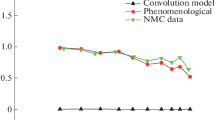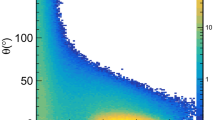Abstract
The mechanism of deuteron formation in neutron-induced reactions is studied within the framework of the isospin-dependent quantum molecular dynamics model, using the GEMINI code. The influence of the \(\hbox {n}\,+\,\hbox {p}\,\rightarrow \,\hbox {d}\) reaction channel is investigated by analyzing the deuteron production cross sections in the neutron-induced reactions \(^{12}\)C(n,d), \(^{16}\)O(n,d), and \(^{28}\)Si(n,d), with incident energies of 20–100 MeV. By including the \(\hbox {n}\,+\,\hbox {p}\,\rightarrow \,\hbox {d}\) reaction channel when modeling the collision, the deuteron production cross sections increase, optimizing the cross-section results and bringing them closer to the experimental data values. This indicates that the \(\hbox {n}\,+\,\hbox {p}\,\rightarrow \,\hbox {d}\) reaction channel is an important mechanism for enhancing deuteron production.




Similar content being viewed by others
References
C.D. Bowman, G.J. Russell, J.W. Davidson et al., Nuclear energy generation and waste transmutation using an accelerator-driven intense thermal neutron source. Nucl. Instrum. Methods A 320, 336 (1992). https://doi.org/10.1016/0168-9002(92)90795-6
B. Rossi, Über die Eigenschaften der durchdringenden Korpuskularstrahlung im Meeresniveau. Z. Phys. 82, 151 (1933). https://doi.org/10.1007/BF01341486
A.J. Koning, T. Fukahori, A. Hasegawa et al., Intermediate energy data. Tech. Rep. NEA-report NEA/WPEC-13,ECN-RX-98-014,OECD/NEA (1998)
D. Filges, F. Goldenbaum, Handbook of Spallation Research: Theory Experiments and Applications (Wiley, Berlin, 2010). https://doi.org/10.1002/9783527628865.ch10
H.A. Abderrahim, P. Baeten, D.D. Bruyn et al., Myrrha, a multipurpose hybrid research reactor for high-end applications. Nucl. Phys. News 20, 24 (2010). https://doi.org/10.1080/10506890903178913
W. Gudowski, Accelerator-driven transmutation projects. The importance of nuclear physics research for waste transmutation. Nucl. Phys. A 654, C436 (1999). https://doi.org/10.1016/S0375-9474(99)00269-9
H.R. Guo, Y.L. Han, C.H. Cai, Theoretical calculation and evaluation of n + 240,242,244Pu reactions. Nucl. Sci. Tech. 30, 13 (2019). https://doi.org/10.1007/s41365-018-0533-7
S. Agostinelli, J. Allison, K. Amako et al., GEANT4-a simulation toolkit. Nucl. Instrum. Methods A 506, 250 (2003). https://doi.org/10.1016/S0168-9002(03)01368-8
M. Durante, Radiation protection in space. Riv. Nuovo. Cimento. 25, 1–70 (2002). https://doi.org/10.1103/RevModPhys.74.235
M.S. Longair, High Energy Astrophysics (Cambridge University Press, New York, 1997). https://doi.org/10.1017/CBO9781139170505
G. Kraft, The radiobiological and physical basis for radiotherapy with protons and heavier ions. Strahlenther. Onkol. 166, 10–13 (1990). https://doi.org/10.1002/ssu.2980060613
A. Boudard, J. Cugnon, J.C. David et al., New potentialities of the Lieoge intranuclear cascade model for reactions induced by nucleons and light charged particles. Phys. Rev. C 87, 014606 (2013). https://doi.org/10.1103/PhysRevC.87.014606
C.W. Ma, C.Y. Qiao, T.T. Ding, Y.D. Song, Temperature of intermediate mass fragments in simulated \(^{40}\)Ca+\(^{40}\)Ca reactions around the Fermi energies by AMD model. Nucl. Sci. Tech. 27, 111 (2016). https://doi.org/10.1007/s41365-016-0112-8
G.S. Bauer, Physics and technology of spallation neutron sources. Nucl. Instrum. Methods A 463, 505 (2001). https://doi.org/10.1016/s0168-9002(01)00167-x
H. Iwase, K. Niita, T. Nakamura, Development of general-purpose particle and heavy ion transport monte carlo code. J. Nucl. Sci. Technol. 39, 1142 (2002). https://doi.org/10.1080/18811248.2002.9715305
G.F. Bertsch, S.D. Gupta, A guide to microscopic models for intermediate energy heavy ion collisions. Phys. Rep. 160, 189 (1988). https://doi.org/10.1016/0370-1573(88)90170-6
J. Aichelin, ’Quantum’ molecular dynamics: a dynamical microscopic n body approach to investigate fragment formation and the nuclear equation of state in heavy ion collisions. Phys. Rep. 202, 233 (1991). https://doi.org/10.1016/0370-1573(91)90094-3
L. Ou, X.Y. He, In-medium nucleon-nucleon elastic cross-sections determined from the nucleon induced reaction cross-section data. Chin. Phys. C 43, 104 (2019)
D.X. Wei, L.H. Mao, N. Wang et al., Further study on mechanism of production of light complex particles in nucleon-induced reactions. Nucl. Phys. A 933, 114 (2015). https://doi.org/10.1016/j.nuclphysa.2014.10.020
Y. Nara, N. Otuka, A. Ohnishi et al., Relativistic nuclear collisions at 10A GeV energies from p+ Be to Au+ Au with the hadronic cascade model. Phys. Rev. C 61, 024901 (1999). https://doi.org/10.1103/PhysRevC.61.024901
A. Boudard, J. Cugnon, S. Leray et al., Intranuclear cascade model for a comprehensive description of spallation reaction data. Phys. Rev. C 66, 044615 (2002). https://doi.org/10.1103/physrevc.66.044615
Y. Yariv, Z. Fraenkel, Intranuclear cascade calculation of high-energy heavy-ion interactions Phys. Rev. C 20, 2227 (1979). https://doi.org/10.1103/PhysRevC.20.2227
Y. Yariv, Z. Fraenkel, Intranuclear cascade calculation of high energy heavy ion collisions: effect of interactions between cascade particles. Phys. Rev. C 24, 488 (1981). https://doi.org/10.1103/PhysRevC.24.488
V.N. Ivanchenko, Geant4 toolkit for simulation of HEP experiments. Nucl. Instrum. Methods A 502, 666 (2003). https://doi.org/10.1016/S0168-9002(03)00538-2
H. Dong, D.Q. Fang, C. Li, Study on the performance of a large-size CsI detector for high energy \(\gamma \)-rays. Nucl. Sci. Tech. 29, 7 (2018). https://doi.org/10.1007/s41365-017-0345-1
S. Furihata, T. Nakamura, Calculation of nuclide productions from proton induced reactions on heavy targets with INC/GEM. J. Nucl. Sci. Technol. 39, 758 (2002). https://doi.org/10.1080/00223131.2002.10875208
S. Furihata, Statistical analysis of light fragment production from medium-energy proton induced reactions. Nucl. Instrum. Methods 171, 251 (2000). https://doi.org/10.1016/s0168-583x(00)00332-3
R.J. Charity, M.A. McMahan, G.J. Wozniak, Systematics of complex fragment emission in niobium-induced reactions. Nucl. Phys. A 483, 371 (1988). https://doi.org/10.1016/0375-9474(88)90542-8
J.J. Gaimard, K.H. Schmidt, A reexamination of the abrasion-ablation model for the description of the nuclear fragmentation reaction. Nucl. Phys. A 531, 709 (1991). https://doi.org/10.1016/0375-9474(91)90748-u
C.W. Ma, D. Peng, H.L. Wei, Z.M. Niu, Y.T. Wang, R. Wada, Isotopic cross-sections in proton induced spallation reactions based on the Bayesian neural network method. Chin. Phys. C 44, 014104 (2020)
K. Niita, S. Chiba, T. Maruyama et al., Analysis of the (N, x N-prime) reactions by quantum molecular dynamics plus statistical decay model. Phys. Rev. C 52, 2620 (1995). https://doi.org/10.1103/PhysRevC.52.2620
D.X. Wei, N. Wang, L. Ou et al., Mechanism of the production of light complex particles in nucleon-induced reactions. J. Phys. G Nucl. Partic. 41, 035104 (2014). https://doi.org/10.1088/0954-3899/41/3/035104
J. Su, F.S. Zhang, B.A. Bian, Odd-even effect in heavy-ion collisions at intermediate energies. Phys. Rev. C 83, 014608 (2011). https://doi.org/10.1103/PhysRevC.83.014608
J. Su, F.S. Zhang, Isotopic dependence of nuclear temperatures. Phys. Rev. C 84, 037601 (2011). https://doi.org/10.1103/PhysRevC.84.037601
J. Su, L. Zhu, W.J. Xie, F.S. Zhang et al., Nuclear temperatures from kinetic characteristics. Phys. Rev. C 85, 017604 (2012). https://doi.org/10.1103/PhysRevC.85.017604
C.C. Guo, J. Su, F.S. Zhang, Comparison between nuclear thermometers in central Xe+Sn collision. Nucl. Sci. Tech. 24, 50513 (2013). https://doi.org/10.13538/j.1001-8042/nst.2013.05.013
J. Su, F.S. Zhang, Non-equilibrium and residual memory in momentum space of fragmenting sources in central heavy-ion collisions. Phys. Rev. C 87, 017602 (2013). https://doi.org/10.1103/PhysRevC.87.017602
J. Su, K. Cherevko, W.J. Xie et al., Nonisotropic and nonsingle explosion in central \({}^{129}\)Xe + \({}^{120}\)Sn collisions at 50–125 MeV/nucleon. Phys. Rev. C 89, 014619 (2014). https://doi.org/10.1103/PhysRevC.89.014619
J. Su, L. Zhu, C.Y. Huang et al., Correlation between symmetry energy and effective \(k\)-mass splitting with an improved isospin-and momentum-dependent interaction. Phys. Rev. C 94, 034619 (2016). https://doi.org/10.1103/PhysRevC.94.034619
J. Su, L. Zhu, C.Y. Huang et al., Effects of symmetry energy and effective \(k\)-mass splitting on central \({}^{96}\text{ Ru }({}^{96}\text{ Zr})+{}^{96}\text{ Zr }({}^{96}\text{ Ru})\) collisions at 50 to 400 MeV/nucleon. Phys. Rev. C 96, 024601 (2017). https://doi.org/10.1103/PhysRevC.96.024601
J. Su, W. Trautmann, L. Zhu et al., Dynamical properties and secondary decay effects of projectile fragmentations in \({}^{124}\text{ Sn },{}^{107}\text{ Sn }+{}^{120}\text{ Sn }\) collisions at 600 MeV/nucleon. Phys. Rev. C 98, 014610 (2018). https://doi.org/10.1103/PhysRevC.98.014610
J. Su, L. Zhu, C.C. Guo et al., Uniform description of breakup mechanisms in central collision, projectile fragmentation, and proton-induced spallation. Phys. Rev. C 100, 014602 (2019). https://doi.org/10.1103/PhysRevC.100.014602
L.W. Chen, F.S. Zhang, G.M. Jin, Analysis of isospin dependence of nuclear collective flow in an isospin-dependent quantum molecular dynamics model. Phys. Rev. C 58, 2283 (1998). https://doi.org/10.1103/PhysRevC.58.2283
Z.Q. Feng, Nuclear dynamics and particle production near threshold energies in heavy-ion collisions. Nucl. Sci. Tech. 29, 40 (2018). https://doi.org/10.1007/s41365-018-0379-z
T.Z. Yan, S. Li, Y.N. Wang, F. Xie, T.F. Yan, Yield ratios and directed flows of light particles from proton-rich nuclei-induced collisions. Nucl. Sci. Tech. 30, 15 (2019). https://doi.org/10.1007/s41365-018-0534-6
J. Xu, L.W. Chen, M.B. Tsang et al., Understanding transport simulations of heavy-ion collisions at \(100A\) and \(400A\) MeV: Comparison of heavy-ion transport codes under controlled conditions. Phys. Rev. C 93, 044609 (2016). https://doi.org/10.1103/PhysRevC.93.044609
Y.X. Zhang, Y.J. Wang, M. Colonna et al., Comparison of heavy-ion transport simulations: Collision integral in a box. Phys. Rev. C 97, 034625 (2018). https://doi.org/10.1103/PhysRevC.97.034625
P.C. Li, Y.J. Wang, Q.F. Li, H.F. Zhang, Collective flow and nuclear stopping in heavy ion collisions in Fermi energy domain. Nucl. Sci. Tech. 29, 177 (2018). https://doi.org/10.1007/s41365-018-0510-1
Y.X. Zhang, N. Wang, Q.F. Li et al., Progress of quantum molecular dynamics model and its applications in heavy ion collisions. Front. Phys. 15, 54301 (2020). https://doi.org/10.1007/s11467-020-0961-9
J. Cugnon, T. Mizutani, J. Vandermeulen, Equilibration in relativistic nuclear collisions. A Monte Carlo calculation. Nucl. Phys. A 3, 505 (1981). https://doi.org/10.1016/0375-9474(81)90427-9
D.D.S. Coupland, W.G. Lynch, M.B. Tsang et al., Influence of transport variables on isospin transport ratios. Phys. Rev. C 84, 054603 (2011). https://doi.org/10.1103/PhysRevC.84.054603
M. Papa, T. Maruyama, A. Bonasera, Constraint molecular dynamics approach to fermionic systems. Phys. Rev. C 64, 024612 (2001). https://doi.org/10.1103/PhysRevC.64.024612
R.J. Charity, Distributions of secondary fragments and the evaporation attractor line. Phys. Rev. C 58, 1073 (1988). https://doi.org/10.1103/PhysRevC.58.1073
Z. Kohley, M. Colonna, A. Bonasera et al., Sensitivity of intermediate mass fragment flows to the symmetry energy. Phys. Rev. C 85, 064605 (2012). https://doi.org/10.1103/PhysRevC.85.064605
Z.F. Zhang, D.Q. Fang, Y.G. Ma, Decay modes of highly excited nuclei. Nucl. Sci. Tech. 29, 78 (2018). https://doi.org/10.1007/s41365-018-0427-8
T. Stiehler, J. Moesner, G. Schmidt et al., The total n-p capture cross section measured at E/sub n/ = 25 MeV. Ann. Phys. Berl. 498, 602 (2010). https://doi.org/10.1002/andp.19864980620
S.T. Hwang, K.J. Lee, K.O. Choi et al., Determination of the ratio of the hydrogen and manganese absorption cross sections by the manganese bath technique. J. Radioanal. Nucl. Ch. 139, 37 (1990). https://doi.org/10.1007/bf02060450
P. Michel, K. Moeller, J. Moesner et al., Measurement of the capture reaction H(n, d)\(\gamma \) at 25.6 MeV. J. Phys. G Nucl. Partic. 15, 1025 (1999). https://doi.org/10.1088/0954-3899/15/7/010
J. Tudoric-Ghemo, Neutron–proton radiative capture at 14.4 MeV. Nucl. Phys. A92, 233 (1967). https://doi.org/10.1016/0375-9474(67)90687-2
M. Cerineo, K. Ilakovac, I. Šlaus et al., Capture of 14.4-Mev neutrons by protons and deuterons. Phys. Rev. 124, 1947 (1961). https://doi.org/10.1103/PhysRev.124.1947
A. Tomyo, Y. Nagai, T.S. Suzuki et al., Measurement of the p(n,\(\gamma \))d reaction cross section between E n = 100 and 350 keV. Nucl. Phys. A718, 401 (2003). https://doi.org/10.1016/S0375-9474(03)00814-5
Y. Nagai, T.S. Suzuki, T. Kikuchi et al., Measurement of H-1 (n, gamma) H-2 reaction cross section at a comparable M-1/ E-1 strength. Phys. Rev. C 56, 3173 (1997). https://doi.org/10.1103/PhysRevC.56.3173
T.S. Suzuki, Y. Nagai, T. Shima et al., First measurement of a p( n, gamma )d reaction cross section between 10 and 80 keV. Astrophys. J. 439(2), L59 (1995). https://doi.org/10.1086/187744
P. Wauters, C. Dupont, P. Leleux et al., Total cross section for the Hn, d) ? reaction at 39, 61, and 76 MeV. Few-Body Syst. 8(1), 1–10 (1990). https://doi.org/10.1007/BF01078871
M. Bosman, A. Bol, J.F. Gilot et al., Measurement of the total cross section for the 1H(n, \(\gamma \)) 2H reaction between 37 and 72 MeV. Phys. Lett. B 82(2), 212–215 (1979). https://doi.org/10.1016/0370-2693(79)90738-X
S. Benck, I. Slypen, J.P. Meulders et al., Experimental cross sections for light-charged particle production induced by neutrons with energies between 25 and 65 MeV incident on aluminum Atom. Data Nucl. Data 78, 161–181 (2001). https://doi.org/10.1006/adnd.2001.0860
S. Benck, I. Slypen, J.P. Meulders, Experimental cross sections for light-charged particle production induced by neutrons with energies between 25 and 65 MeV incident on oxygen. Atom. Data Nucl. Data 78, 1–20 (1999). https://doi.org/10.1006/adnd.1999.0806
I. Slypen, S. Benck, J.P. Meulders, Light charged particle production in fast neutron-induced reactions on carbon (En=20 to 75 MeV): (I). Protons and deuterons. Nucl. Phys. A 671, 3–19 (2000). https://doi.org/10.1016/S0375-9474(99)00829-5
Author information
Authors and Affiliations
Corresponding author
Additional information
This work was supported by the National Natural Science Foundation of China (Nos. 11875328 and U1832182), the Natural Science Foundation of Guangdong Province, China (No. 18zxxt65), and Fundamental Research Funds for the Central Universities (19lgpy306 and 18lgpy87).
Rights and permissions
About this article
Cite this article
He, YJ., Guo, CC., Su, J. et al. Study on deuteron formation mechanism in nucleon-induced reactions. NUCL SCI TECH 31, 84 (2020). https://doi.org/10.1007/s41365-020-00788-5
Received:
Revised:
Accepted:
Published:
DOI: https://doi.org/10.1007/s41365-020-00788-5




